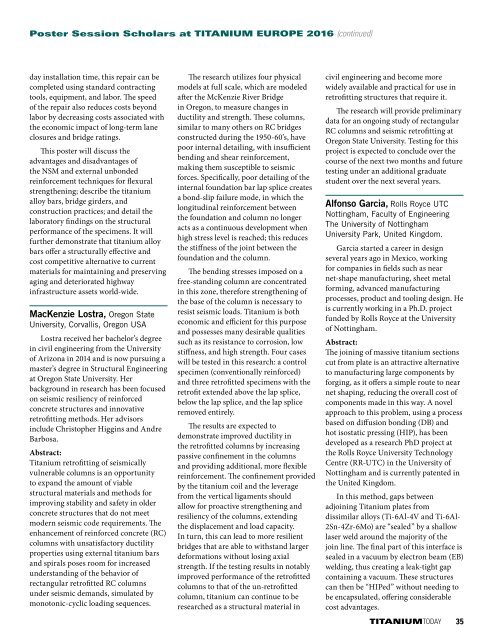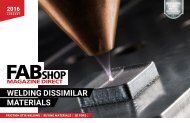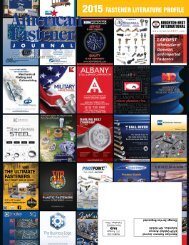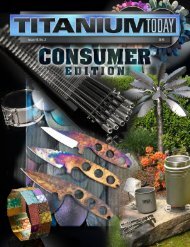100% Positive Material Identification
23mhiW2
23mhiW2
You also want an ePaper? Increase the reach of your titles
YUMPU automatically turns print PDFs into web optimized ePapers that Google loves.
Poster Session Scholars at TITANIUM EUROPE 2016 (continued)<br />
day installation time, this repair can be<br />
completed using standard contracting<br />
tools, equipment, and labor. The speed<br />
of the repair also reduces costs beyond<br />
labor by decreasing costs associated with<br />
the economic impact of long-term lane<br />
closures and bridge ratings.<br />
This poster will discuss the<br />
advantages and disadvantages of<br />
the NSM and external unbonded<br />
reinforcement techniques for flexural<br />
strengthening; describe the titanium<br />
alloy bars, bridge girders, and<br />
construction practices; and detail the<br />
laboratory findings on the structural<br />
performance of the specimens. It will<br />
further demonstrate that titanium alloy<br />
bars offer a structurally effective and<br />
cost competitive alternative to current<br />
materials for maintaining and preserving<br />
aging and deteriorated highway<br />
infrastructure assets world-wide.<br />
MacKenzie Lostra, Oregon State<br />
University, Corvallis, Oregon USA<br />
Lostra received her bachelor’s degree<br />
in civil engineering from the University<br />
of Arizona in 2014 and is now pursuing a<br />
master’s degree in Structural Engineering<br />
at Oregon State University. Her<br />
background in research has been focused<br />
on seismic resiliency of reinforced<br />
concrete structures and innovative<br />
retrofitting methods. Her advisors<br />
include Christopher Higgins and Andre<br />
Barbosa.<br />
Abstract:<br />
Titanium retrofitting of seismically<br />
vulnerable columns is an opportunity<br />
to expand the amount of viable<br />
structural materials and methods for<br />
improving stability and safety in older<br />
concrete structures that do not meet<br />
modern seismic code requirements. The<br />
enhancement of reinforced concrete (RC)<br />
columns with unsatisfactory ductility<br />
properties using external titanium bars<br />
and spirals poses room for increased<br />
understanding of the behavior of<br />
rectangular retrofitted RC columns<br />
under seismic demands, simulated by<br />
monotonic-cyclic loading sequences.<br />
The research utilizes four physical<br />
models at full scale, which are modeled<br />
after the McKenzie River Bridge<br />
in Oregon, to measure changes in<br />
ductility and strength. These columns,<br />
similar to many others on RC bridges<br />
constructed during the 1950-60’s, have<br />
poor internal detailing, with insufficient<br />
bending and shear reinforcement,<br />
making them susceptible to seismic<br />
forces. Specifically, poor detailing of the<br />
internal foundation bar lap splice creates<br />
a bond-slip failure mode, in which the<br />
longitudinal reinforcement between<br />
the foundation and column no longer<br />
acts as a continuous development when<br />
high stress level is reached; this reduces<br />
the stiffness of the joint between the<br />
foundation and the column.<br />
The bending stresses imposed on a<br />
free-standing column are concentrated<br />
in this zone, therefore strengthening of<br />
the base of the column is necessary to<br />
resist seismic loads. Titanium is both<br />
economic and efficient for this purpose<br />
and possesses many desirable qualities<br />
such as its resistance to corrosion, low<br />
stiffness, and high strength. Four cases<br />
will be tested in this research: a control<br />
specimen (conventionally reinforced)<br />
and three retrofitted specimens with the<br />
retrofit extended above the lap splice,<br />
below the lap splice, and the lap splice<br />
removed entirely.<br />
The results are expected to<br />
demonstrate improved ductility in<br />
the retrofitted columns by increasing<br />
passive confinement in the columns<br />
and providing additional, more flexible<br />
reinforcement. The confinement provided<br />
by the titanium coil and the leverage<br />
from the vertical ligaments should<br />
allow for proactive strengthening and<br />
resiliency of the columns, extending<br />
the displacement and load capacity.<br />
In turn, this can lead to more resilient<br />
bridges that are able to withstand larger<br />
deformations without losing axial<br />
strength. If the testing results in notably<br />
improved performance of the retrofitted<br />
columns to that of the un-retrofitted<br />
column, titanium can continue to be<br />
researched as a structural material in<br />
civil engineering and become more<br />
widely available and practical for use in<br />
retrofitting structures that require it.<br />
The research will provide preliminary<br />
data for an ongoing study of rectangular<br />
RC columns and seismic retrofitting at<br />
Oregon State University. Testing for this<br />
project is expected to conclude over the<br />
course of the next two months and future<br />
testing under an additional graduate<br />
student over the next several years.<br />
Alfonso Garcia, Rolls Royce UTC<br />
Nottingham, Faculty of Engineering<br />
The University of Nottingham<br />
University Park, United Kingdom.<br />
Garcia started a career in design<br />
several years ago in Mexico, working<br />
for companies in fields such as near<br />
net-shape manufacturing, sheet metal<br />
forming, advanced manufacturing<br />
processes, product and tooling design. He<br />
is currently working in a Ph.D. project<br />
funded by Rolls Royce at the University<br />
of Nottingham.<br />
Abstract:<br />
The joining of massive titanium sections<br />
cut from plate is an attractive alternative<br />
to manufacturing large components by<br />
forging, as it offers a simple route to near<br />
net shaping, reducing the overall cost of<br />
components made in this way. A novel<br />
approach to this problem, using a process<br />
based on diffusion bonding (DB) and<br />
hot isostatic pressing (HIP), has been<br />
developed as a research PhD project at<br />
the Rolls Royce University Technology<br />
Centre (RR-UTC) in the University of<br />
Nottingham and is currently patented in<br />
the United Kingdom.<br />
In this method, gaps between<br />
adjoining Titanium plates from<br />
dissimilar alloys (Ti-6Al-4V and Ti-6Al-<br />
2Sn-4Zr-6Mo) are “sealed” by a shallow<br />
laser weld around the majority of the<br />
join line. The final part of this interface is<br />
sealed in a vacuum by electron beam (EB)<br />
welding, thus creating a leak-tight gap<br />
containing a vacuum. These structures<br />
can then be “HIPed” without needing to<br />
be encapsulated, offering considerable<br />
cost advantages.<br />
TITANIUMTODAY 35







